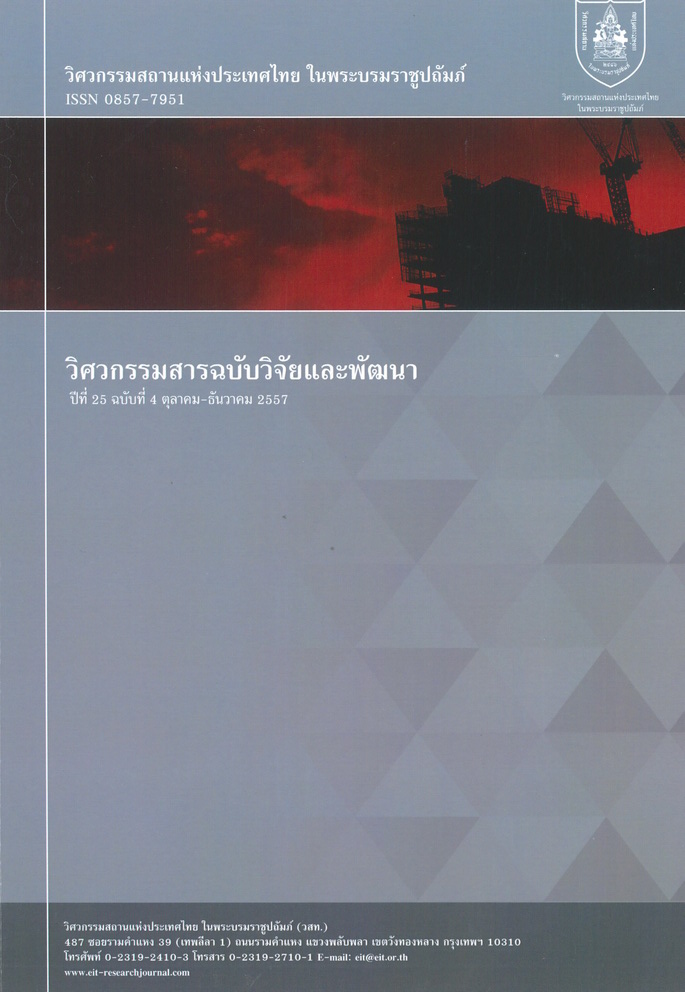A STUDY ON SALINITY INTRUSION AND CONTROL MEASURE IN THE THACHIN RIVER
Main Article Content
Abstract
การศึกษาครั้งนี้มีวัตถุประสงค์เพื่อหามาตรการควบคุมความเค็มที่เหมาะสมซึ่งเกิดจาการรุกล้ำความเค็มจากปากแม่น้ำท่าจีนที่เพิ่มขึ้นอย่างต่อเนื่องทุกปี โดยแบบจำลองคณิตศาสตร์ได้ถูกนำมาประยุกต์ในการวิเคราะห์การรุกล้ำความเค็ม ผลการวิเคราะห์พบว่าการรุกล้ำความเค็มจะมีระยะทางเพิ่มขึ้นในอนาคตอันเนื่องมาจากการเพิ่มขึ้นของระดับน้ำทะเลที่ปากแม่น้ำและผลการพยากรณ์การรุกล้ำความเค็มในปี พ.ศ. 2558 2563 และ 2568 พบว่าค่าความเค็มจะรุกล้ำเข้าไปเป็นระยะทางสูงสุด 55 กิโลเมตรจากปากแม่น้ำโดยคิดเป็นระยะทางที่เพิ่มขึ้นจากสภาพปัจจุบัน 3 กิโลเมตรตามแนวยาวลำน้ำ ดังนั้นการควบคุมความเค็มเพื่อลดผลกระทบดังกล่าวจะใช้มาตรการเพิ่มอัตราการไหลในแม่น้ำท่าจีน ผลการวิเคราะห์พบว่าการเพิ่มอัตราการไหลจะแปรผันโดยตรงกับระยะทางการขับไล่ความเค็มที่เพิ่มขึ้น อย่างไรก็ตาม การเพิ่มขึ้นของระยะทางการขับไล่ความเค็มไม่ได้เป็นสัดส่วนเดียวกับในทุกๆ ช่วงของการเพิ่มขึ้นของอัตราการไหล โดยอัตราการไหลที่เหมาะสมต่อการขับไล่ความเค็มของแม่น้ำท่าจีนจะอยู่ที่ประมาณ 20-40 ลบ.ม.ต่อวินาที เพราะอัตราการไหลดังกล่าวนี้จะขับไล่ความเค็มให้ออกไปได้ระยะทางไกลกว่าเมื่อเปรียบเทียบกับการเพิ่มอัตราการไหลที่สูงกว่านี้ และอีกประการหนึ่งคือการเพิ่มอัตราการไหลในปริมาณที่มากเกินกว่าความจุลำน้ำอาจก่อให้เกิดปัญหาน้ำล้นตลิ่งซึ่งจะส่งผลกระทบต่อเกษตรกรริมฝั่งแม่น้ำได้
This study aims to consider the suitable salinity control measure affected by salinity intrusion in ThaChin estuarine which has an increasing trend to continuous occurred every year. The mathematical model was applied for an analysis of salinity intrusion. The results showed that salinity intrusion will increase further upstream in the future because of the rise of sea level at the estuarine, and the forecast result of salinity intrusion in the year 2015, 2020 and 2025 showed that the salinity would be intruded to a maximum distance of 55 km from the estuarine which is around 3 km further upstream along the river comparing to the existing condition. Consequently, to control the salinity for reducing the impact, the increasing of flow rate in ThaChin river was considered as a measure. The results showed that the increasing flow rate is directly proportional to the increasing distance downstream of repel salinity. However, the increasing distance of repel salinity is not the same proportion for every range of the increasing flow rate. The appropriate flow rates for repelling salinity in ThaChin River are around 20-40 cms. Because these flow rates will repel salinity to leave more distance downstream comparing with other higher flow rates. In addition, the higher flow rates in excessive amounts of river capacity may cause inundation problems, which will affect the farmers along the river.
Article Details
The published articles are copyright of the Engineering Journal of Research and Development, The Engineering Institute of Thailand Under H.M. The King's Patronage (EIT).


